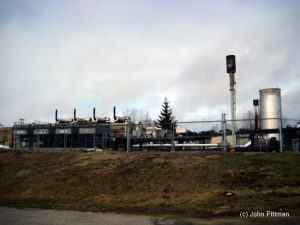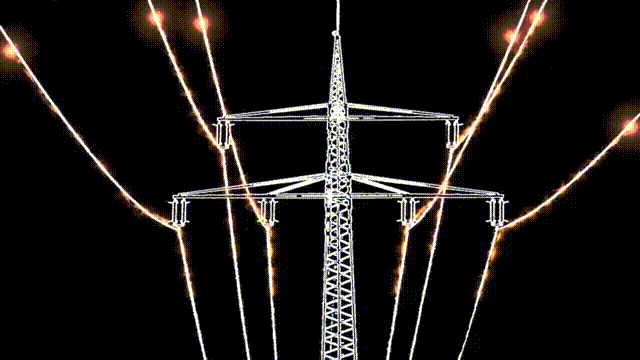Electricity generation from biogas is not new. There are already millions of biogas plants in operation throughout the world and many provide electricity. The biogas generators needed to produce electricity from biogas are available at all scales of output. Plus, the technology to clean up the raw biogas before it is combusted is available, tried and tested, and ready for use wherever it is needed.
Electricity generation from biogas is seen as having significant potential in the field of alternative energy, and to assist governments in achieving their “Paris Accord” targets for carbon reduction in compliance with global climate change reduction agreements.
Electricity Generation by Internal Combustion Engines
An internal combustion engine converts biogas to mechanical energy. Mechanical energy turns an electric generator, which generates electricity.
Biogas generation systems that provide onsite renewable energy are used to power and heat farms and facilities, generate electric power for grid sales, and support electric power generation utilities.
Onsite biogas power generation plants can be installed to generate electricity, heat, and/or cooling, and can be used by farms and businesses to power a variety of applications.
Biogas Engines
Internal combustion engines are commonly referred to as biogas engines because they use biogas to generate mechanical energy. Biogas is carefully mixed with the appropriate amount of air before being drawn into the biogas engine by the force of the engine pistons moving downwards, creating a vacuum.
The biogas is then compressed further by a controlled explosion, and the resulting rotational force drives a rotating shaft within an attached electrical generator. Alternating current electricity is produced by the effect of current flowing through wire coils within the generator.
The majority of large new biogas plants no longer generate electricity for electrical grid supply.
Since 2017 there has been a sustained trend for new biogas plants to incorporate purification (upgrading) equipment to produce virtually pure methane interchangeable with natural gas for injection into natural gas grids.
For a variety of reasons, this is recognised as a better, more sustainable, use of biogas than electricity generation.
Alternators or Dynamos
Because most generators produce alternating current electricity, they are also known as alternators or dynamos. Appropriate electric generators are available in almost every country and in every size.
Alternatives to Internal Combustion Engines
Internal combustion engines aren't the only way to generate electricity from biogas. Stirling engines and jet turbines are alternatives. Steam turbines are almost never used. This equipment is typically used to generate large amounts of steam in larger industrial applications. This technology is used in power plants or waste recovery sites that use incineration.
Fuel Cells
Biogas can theoretically be converted directly into electricity using a fuel cell. However, this process necessitates very clean gas and costly fuel cells. For many years, top-of-the-line domestic boilers have been available that can do this. This option, however, is still a matter for large-scale research and is not usually a practical option for biogas plant operators.
Generator Sets for Electricity Generation from Biogas
The most common method of generating electricity from biogas is the conversion of biogas to electric power via a generator set.
In most cases, even common 3-phase electric motors can be converted into generators.
Combustion engines are popular for small-size heat engines because they are more efficient and less expensive than small gas turbines. However, gas turbines may be more efficient when used in a cogeneration cycle that generates both heat and electricity.
Cogeneration – Combined Heat and Power (CHP)
Cogeneration, also known as combined heat and power (CHP), is the simultaneous generation of electricity and useful heat. In general, heat engines (also known as thermal power plants) do not convert all of their thermal energy into electricity.
The technology is well-known, and maintenance is straightforward.
Farms and businesses can use biogas power plants to generate their own electricity, heating, and cooling by utilising a variety of technologies.
The economic viability, and aims, of those that use electricity generation from biogas, vary according to the size of the biogas plant and whether the site has mains electricity or is off-grid.
In the sections which follow we look at electricity generation from biogas on the small scale to large:
Electricity generation from Small Scale Biogas Plants (Home Biogas)
Generator sets can be bought from retail outlets for the smaller biogas plant outputs, from single-home to community-digester sizes. It is not normally viable to buy and pay-back the cost in reduced electricity charges for small bio-digesters if a mains power supply is already available.
However, if these are sold more for off-grid use where the site would be without electricity that's a different matter.
Biogas electricity can make an enormous difference to the quality of life off-grid, by allowing families good lighting in winter and other facilities such as TV, phone charging, and even broadband internet access.
This use of electricity generation from biogas is set to continue to expand for small-scale biogas plants. However, this is only one example of biogas electricity generation potential.
The other biogas sources used for electricity, which we will discuss here, are as follows:
– Commercial on-farm biogas
– Landfill Site Biogas
– Wastewater Sludge Biogas from Municipal Sewage Treatment Works
Large Biogas Plant and Commercial On-Farm Electricity Generation from Biogas
For larger biogas installations electricity generation is often used to power the farm, and may also be fed to neighbouring dwellings and businesses, especially if the locality is off-grid. Where farms are on-grid, which amounts to most AD facilities in the developed nations, the AD plant commonly also feeds surplus power into the local and national power grids.
The decision whether to install a biogas plant in these circumstances often rests upon whether it will be economically viable to supply power to the grid, based on the price paid for power through the local Feed-in-Tariff.
Landfill Site Biogas Electricity Generation
In Europe and other many other developed nations, there have been environmental laws in place for many years which require landfill owners/ operators to extract landfill gas. This is in order to avoid the methane discharges from landfills which otherwise pose a high burden on the climate, due to the high greenhouse gas (GHG) effect of the discharge of methane.
Electricity generation from biogas is much more viable in jurisdictions where the landfill operator must by law, already install a landfill gas (LFG) extraction system. In such circumstances, the cost of the extraction system is notionally a charge added to the waste tipping gate fee. That way, it is much easier to show a profit on selling the power, once the LFG extraction-overhead is attributed elsewhere.
That collecting and burning landfill gas should be a cost borne by all responsible global communities is now incontestable given the knowledge scientists now have about the greenhouse effect and climate change.
How Damaging is it Not to Collect and Flare or Utilize Landfill Gas?
Experts say that discharging methane into the atmosphere is over 20* times as damaging in terms of the climate-changing greenhouse gas effect, as the emission of the carbon dioxide from that gas after it has been burnt in a flare or a gas engine.
* [In 2021, this ratio was updated to 60 to 80 times by the IPCC following research on the half-life of methane decay in the atmosphere.]
 Given global pledges under the Paris accord [and at subsequent COP events] to cut carbon dioxide emissions massively over the coming years, for governments to pass laws requiring landfill gas extraction and flaring, or utilization must be assumed to be a no-brainer.
Given global pledges under the Paris accord [and at subsequent COP events] to cut carbon dioxide emissions massively over the coming years, for governments to pass laws requiring landfill gas extraction and flaring, or utilization must be assumed to be a no-brainer.
Not taking advantage of this opportunity for GHG emission reduction, seems to be a huge missed opportunity. A large amount of carbon emission reduction is usually the cheapest, by requiring all LFG to be flared or used than any other method.
Prevention of the leakage of landfill gas (biogas) to the atmosphere is in fact, “low hanging fruit” for governments to pick when starting out to reduce their carbon emissions.
This will be the case for all nations where energy costs are not depressed by local renewable or fossil fuel sources.
In New Zealand, national framework conditions are not usually favourable for feeding electricity into the grid, due to the low cost of electricity generation from hydro-power. The same is no doubt true for large parts of the US where there are local oil wells and fracking. Although, under the US EPA LMOP Scheme there are moves to rapidly raise landfill gas extraction and its use, or flaring in order to reduce US carbon emissions.
In such areas, the lack of economic viability will mean that electricity from biogas will remain limited to a few pilot applications. At least, unless or until the government raises its priority for carbon emissions reduction. However, even in these locations cost analysis indicates that electricity generation from biogas can be environmentally benign and sensible for an integrated farm unit.
An example of “integrated farm unit” electricity generation from biogas, which is still viable even when local energy prices are low, is large US dairy farms.
There has been a gradual uptake of anaerobic digestion at such large farms for the last 10 years or more. These schemes are generally very successful when the benefits of AD for farm waste management in savings on bought-in fertilizer costs, are factored in.
Wastewater Sludge Biogas from Municipal Sewage Treatment Works
Around the world, many municipal sewage works operators have discovered the huge potential for anaerobic digestion for electricity generation. Installing AD plants for biogas production also removes their previous headache, which was finding ways to dispose of the huge tonnages of sewage sludge they produce. This organic material is removed daily from every Wastewater Treatment Works while treating the foul sewage before the cleaned-up water is discharged into the local watercourses.
The problem for sewage-sludge biogas production in the past was that it was a very slow process (generally slower than farm biogas plants) and much of the organic content just washed out after digestion in the digestate, albeit having successfully treated the sludge for space disposal.
Now it is becoming a much more efficient process.
Recent there have been developments in pre-treating the sewage sludge before it enters the digester so that the initially hard-to-digest sludge cellular structure is “lysed” before the organic matter/ sludge enters the digester.
By lysed we mean that the tough cell walls are broken to allow the methane-producing organisms to consume much more of the cell contents. This is done by a process called hydrolysis, and better and lower energy-consuming methods of hydrolysis are now emerging that break down the cells much more effectively than in the past.
The result is that many sewage treatment works can now power the entire sewage works most of the time from the electricity made from their own biogas. Plus, they can sell the excess power into the local electricity grid. A lot of work is going on currently to find ways of getting more and more energy from sewage sludges per tonne of sludge.
It is likely that even today's best lysing (hydrolysis) technology will be substantially bettered, over the coming years. The wonderful point to make here is that, of course, all this energy from sewage sludge will be renewable energy.
A Possible Problem for Electricity Generation from Biogas
Electricity generation from biogas does hold one weakness though, and this may result in a lot of the biogas produced being diverted for another use in the next 5 to 10 years. Diverted to use it (after purification and compression) as a transport fuel.
Governments the world over are urgently seeking to reduce city air pollution and need a short-term fix before the long hoped-for advent of electric fuel-cell vehicles.
Using biogas for transport fuel use, due to its excellent clean burning properties is not only a more efficient use of the biogas resource than electricity generation, but it is also available now.
Vehicle manufacturers can, and are, readily modifying their engines for HGV and bus fleets to use compressed upgraded biogas (rCNG) as the fuel.
This use will increasingly compete with the use of biogas for electricity generation for on-farm and commercial biogas plant outputs. However, overall we would expect electricity generation from biogas to continue to increase due to new biogas plants being brought on-stream, despite the new competition from biomethane rCNG production.
Conclusion
Making electricity from home biogas can be very advantageous for people in developing nations, and greatly improve the quality of life off-grid.
Large-scale electricity generation from biogas makes sense for the health of our planet at all scales.
In large-scale AD plants and for landfill gas sources, there will be an increasing trend toward biogas use for transport fuel use.
However, overall large-scale AD plant electricity generation from biogas is likely to continue to rise globally.
[Published 28 August 2018. Updated with added information July 2022.]








this is great! – in australia we use solar to power the dairy during the day – unfortunately we do not use the biogas waste. all our waste produced is just that! smells as well!
Great post! Here in Indian rural areas, people use biogas to generate fuel to cook food. But this is a way can add another use, and use the gas as a source to generate electricity.
Biogas electricity generation is a proven and sustainable alternative energy source with significant potential. It’s time for governments to embrace this technology and accelerate their efforts to meet carbon reduction targets